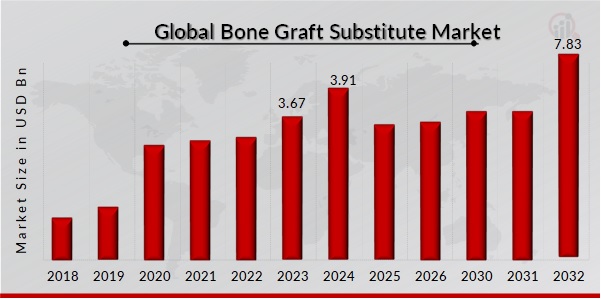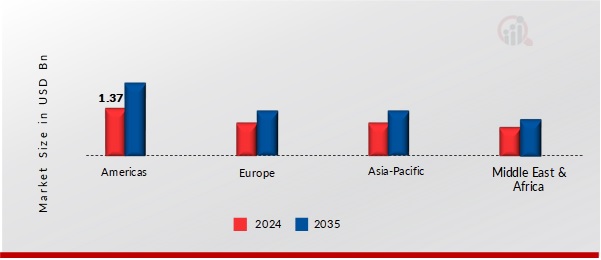Global Bone Graft Substitute Market Overview
The Bone Graft Substitute Market was valued at USD 3.67 billion in 2024. The industry is projected to grow from USD 3.91 billion in 2025 to USD 7.83 billion by 2035, exhibiting a compound annual growth rate (CAGR) of 6.52% during the forecast period (2025 - 2035).
The rising incidence of road injuries and joint disorders and development of biocompatible synthetic bone grafts are driving the market growth.

Source: Secondary Research, Primary Research, MRFR Database, and Analyst Review
Bone Graft Substitute Market Trends
Rising incidence of road injuries and joint disorders
Bone grafting is a surgical technique used to fix problems by using transplanted bone to repair, rebuild, and replace missing bones and reconstructing joint disorders. It is possible because bone tissue can regenerate completely once the space is provided into which it has to grow as natural bone.
The rate of road injuries is on the rise. For instance, according to the Sustainable Transport Conference 2021, boys and men account for 75% of road fatalities, highlighting a significant gender disparity in traffic-related deaths. Additionally, between 20 and 50 million people suffer non-fatal injuries each year due to road traffic crashes. Alarmingly, 93% of the world's road fatalities occur in low- and middle-income countries, despite these nations having only about 60% of the world's vehicles. Furthermore, the death rate from road crashes in low-income countries is more than 3.5 times higher than in high-income countries, underscoring the disproportionate impact of road traffic accidents in these regions.
Bone grafting has numerous applications in fixing injuries and diseases. It may be used in the case of multiple or complex fractures or those that do not heal well after initial treatment. It is also used for fusion which helps two bones heal across a diseased joint. Fusion is most often done on the spine. Regeneration is used for bone lost to disease, infection, or injury. This can involve using small amounts of bone in bone cavities or large sections of bones and a graft can be used to help bone heal around surgically implanted devices, like joint replacements, plates, or screws. Hence, with all these applications, bone grafting poses is an effective technique to treat road injuries and joint disorders.
Bone Graft Substitute Market Segment Insights
Global Bone Graft Substitute Type Insight
On the basis of type, the Bone Graft Substitute Market has been segmented into allograft, bone graft substitute, and cell-based matrices. Allografts are further segmented into machined allograft and demineralized bone matrix. Bone graft substitute is further segmented into bone morphogenic proteins (BMP) and synthetic bone grafts. The allograft segment dominated the market in 2023. The allograft segment is projected to be the fastest-growing segment.
A bone graft substitute can be defined as a synthetic, inorganic, or biologically organic combination, which can be inserted for the treatment of a bone defect instead of autogenous or allogenous bone. Even though autografts are considered as the ‘gold standard’ for bone grafting procedures, bone graft substitute has become one of the popular routes for administration among many medical users due to the double incision required in the autografting procedure, and the pain associated with the procedure and the post-operative pain on both the sites.
Allografts are the logical replacement for autograft. Allograft is harvested from an individual other than the one receiving the graft. It is mostly taken from cadavers that have donated their bone so that it can be used for people who are alive and in need; it is typically sourced from a bone bank. However, there is a high risk of disease transmission while using these allografts for bone grafting as the body from which it is taken may be carrying the disease. Hence, these bones are highly processed and sterilized to reduce the chances of disease transmission. Allografts are segmented into machine allografts and Demineralized Bone Matrix (DBM).
Figure 2: Bone Graft Substitute Market SIZE, BY TYPE, 2024 & 2035 (USD Billion)

Source: Secondary Research, Primary Research, MRFR Database, and Analyst Review
Global Bone Graft Substitute Application Insights
Applications of bone graft substitutes are increasing rapidly as other bone graft types such as autografts and allografts have disadvantages, such as limited availability, site morbidity and pain, and prone to infections. In fact, DBM are used in 50% of allografts performed in the US. The Bone Graft Substitute Market , by application, is segmented into dental, foot & ankle, joint reconstruction, long bone, and spinal fusion. The spinal fusion segment dominated the market in 2020. The spinal fusion segment is projected to be the fastest-growing segment during the study period.
Spinal fusion is an extremely important procedure wherein a solid bridge is formed between two vertebral of the spines to stop the movement in that section. It is very important to understand that bone grafts do not directly heal the spinal distress or carry out the spinal fusion. However, bone graft creates an environment for that solid bridge to form. Bone graft provides a foundation for the spine and allows the body to regenerate the bone and fuse the section of the spine. They provide stability to the spine while the body heals itself.
Global Bone Graft Substitute Regional Insights
On the basis of region, the Bone Graft Substitute Market has been segmented into the Americas, Europe, Asia-Pacific, and the Middle East & Africa. Americas held the largest market in 2023, and Asia-Pacific is accounted for the fastest growing region during the forecast period.
The Americas is further segmented into North America and Latin America. North America accounted for a largest market in 2023, and expected to show steady growth. The North American market is further divided into the US and Canada. The largest market share of 81.0% of North Americas is due to several factors such as high volumes of orthopedic surgeries, adoption of bone graft substitutes, and the presence of prominent key players. In addition, the presence of major market players in this region involved in product innovation expansion, expansion, and strategic collaborations, and well-developed healthcare infrastructure are contributing towards the market growth. For instance, in February 2019, Medtronic plc announced approval and launch of Japan's first Grafton Demineralized Bone Matrix (DBM) bone grafting product for spine and orthopedic procedures.
Figure 3: Bone Graft Substitute Market BY REGION 2024 & 2035 (USD Billion)

Source: Secondary Research, Primary Research, MRFR Database, and Analyst Review
Global Bone Graft Substitute Key Market Players & Competitive Insights
The Bone Graft Substitute Market is distinguished by the presence of numerous regional and local players catering to the Bone Graft Substitute Market . Furthermore, the rising incidence of road injuries and joint disorders and development of biocompatible synthetic bone grafts are driving the Bone Graft Substitute Market .
The Bone Graft Substitute Market is extremely competitive, with players competing and investing heavily in the development of innovative products to gain a significant market share. The market is highly fragmented with high competition in the market, increasing collaborative partnerships, and other strategic decisions to achieve operational efficiency.
The growth of prominent industry players is dependent on various factors, such as market conditions, product differentiation and innovation, and pricing strategies. It is also projected that upsurge in demand for orthopedic procedures among geriatric population and high investment in orthopedic care sector will boost the market's growth in the upcoming future.
Key Companies in the Bone Graft Substitute Market include.
- Johnson & Johnson Inc. (US)
- Baxter (US)
- Integra Lifesciences Holdings Corporation (US)
- Orthox Medical Inc. (US)
- Geistlich Pharma AG (Switzerland)
- Medtronic (Ireland)
- AlloSource (Colorado)
- Zimmer Biomet (US)
- Stryker (US)
- Smith & Nephew (US)
Global Bone Graft Substitute Industry Developments
December 2024: Zimmer Biomet Holdings, Inc. received U.S. Food and Drug Administration (FDA) clearance for the OsseoFit Stemless Shoulder System for total shoulder replacement. This innovative implant is designed to match the natural humeral (upper shoulder bone) anatomy1-3 to optimize anatomical fit while maximizing preservation of healthy bone.
May 2024: Medtronic received FDA approval for the Infuse bone transplant, which includes an intervertebral fusion device and a commercially available metallic screw and rod system. This designation refers to the use of Infuse bone graft in a transforaminal lumbar interbody fusion (TLIF) surgical procedure at one or two adjacent levels from L2 to S1 in the treatment of degenerative disorders of the lumbosacral spine.
November 2023: Smith+Nephew has signed a definitive agreement to buy CartiHeal, the developer of Agili-C, a revolutionary sports medicine technology for knee cartilage regeneration. Under the terms of the agreement, Smith+Nephew will pay an initial cash consideration of $180 million at closing, with an additional $150 million based on financial performance.
March 2022: Biocomposites entered into partnership with Zimmer Biomet, a global medical technology leader, to exclusively supply genex Bone Graft Substitute with its novel mixing system and delivery options in the US orthopaedic market.
Bone Graft Substitute Market Segmentation
-
Global Bone Graft Substitute Type Outlook
- Allograft
- Bone Graft Substitute
- Cell-Based Matrices
-
Global Bone Graft Substitute Form Outlook
- Spinal Fusion
- Joint Reconstruction
- Long Bone
- Dental
- Foot & Ankle
- Others
-
Global Bone Graft Substitute Regional Outlook
-
Americas
- North America
- US
- Canada
- Latin America
-
Europe
- Western Europe
- Germany
- France
- UK
- Italy
- Spain
- Rest of Western Europe
- Eastern Europe
-
Asia-Pacific
- China
- Japan
- India
- South Korea
- Australia
- Rest of Asia-Pacific
-
Middle East & Africa
|
Report Attribute/Metric
|
Details
|
|
Market Size 2024
|
USD 3.67 billion
|
|
Market Size 2025
|
USD 3.91 billion
|
|
Market Size 2035
|
USD 7.83 billion
|
|
Compound Annual Growth Rate (CAGR)
|
6.52% (2025-2035)
|
|
Base Year
|
2024
|
|
Forecast Period
|
2025-2035
|
|
Historical Data
|
2019 to 2023
|
|
Forecast Units
|
Value (USD Billion)
|
|
Report Coverage
|
Revenue Forecast, Market Competitive Landscape, Growth Factors, and Trends.
|
|
Segments Covered
|
Type, Application and Region
|
|
Key Companies Profiled
|
Johnson & Johnson Inc. (US), Baxter (US), Integra Lifesciences Holdings Corporation (US), Orthox Medical Inc. (US), Geistlich Pharma AG (Switzerland), Medtronic (Ireland), AlloSource (Colorado), Zimmer Biomet (US), Stryker (US), Smith & Nephew (US)
|
|
Key Market Opportunities
|
· High investment in orthopedic care sector
· Upsurge in demand for orthopedic procedures among geriatric population
|
|
Key Market Dynamics
|
· Rising incidence of road injuries and joint disorders
· Development of biocompatible synthetic bone grafts
|
Bone Graft Substitutes Market Highlights:
Frequently Asked Questions (FAQ) :
The Bone Graft Substitute Market is anticipated to reach 7.83 billion at a CAGR of 6.52% during the forecast period of 2024-2035.
The Bone Graft Substitute Market is expected to grow at a 6.52% CAGR during the forecast period from 2025 to 2035.
The North America region market is estimated to hold the largest market share in the Bone Graft Substitute Market .
The key players include Johnson & Johnson Inc. (US), Baxter (US), Integra Lifesciences Holdings Corporation (US), Orthox Medical Inc. (US), Geistlich Pharma AG (Switzerland), Medtronic (Ireland), AlloSource (Colorado), Zimmer Biomet (US), Stryker (US), Smith & Nephew (US).
Allografts segment dominated the market in 2024.

















